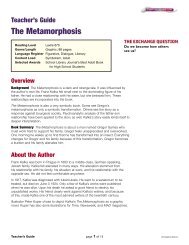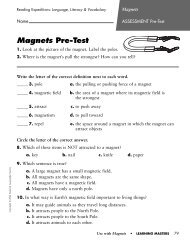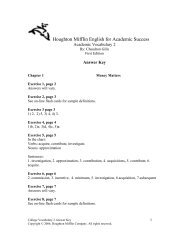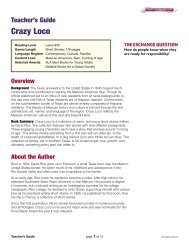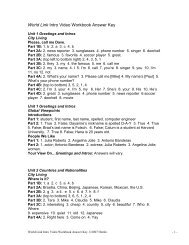Weaving It Together
Weaving It Together
Weaving It Together
You also want an ePaper? Increase the reach of your titles
YUMPU automatically turns print PDFs into web optimized ePapers that Google loves.
UNIT 3<br />
CD 1<br />
Track 5<br />
Chapter<br />
5<br />
28 Unit 3<br />
Personality Revealed<br />
The readings and follow-up activities in<br />
this unit focus on the interconnections<br />
among body, mind, and personality.<br />
Chapter 5 suggests how a person’s<br />
physical form may reveal personality<br />
characteristics. Chapter 6 looks at how<br />
pets affect our mental and physical health.<br />
Here are some interesting facts about<br />
phrenology, the study of bumps on the<br />
head:<br />
• Although phrenology is not regarded as<br />
a science, it provided an important fi rst<br />
step toward modern medical research<br />
into how different areas within the brain<br />
function.<br />
• During the nineteenth century, some<br />
people studied phrenology in an attempt<br />
to fi nd compatible marriage partners.<br />
Warm-Up<br />
Mind and Body<br />
You may start the lesson in one of these<br />
ways:<br />
• Ask students to describe what the person<br />
in the photo on page 53 is doing. Invite<br />
anyone who knows to explain what tai<br />
chi is. (The person practices a set of slow<br />
physical movements that look like ballet<br />
while concentrating the mind deeply<br />
on the process. Regular practice of tai<br />
chi is said to boost the immune system,<br />
decrease anxiety and depression, and<br />
reduce asthma and allergy problems.)<br />
• Bring in photos of different fi lm stars<br />
or personalities. Number them and put<br />
them up on the walls of your classroom.<br />
Have students walk around and identify<br />
each numbered photo a personality trait.<br />
Then compare results on the board.<br />
Reading<br />
Before the fi rst reading, write the words<br />
physiognomy and phrenology on the board.<br />
Divide the class into two groups. Ask one<br />
group to read the second paragraph about<br />
physiognomy and the other to read the<br />
fourth paragraph about phrenology. Then<br />
call on students from the two groups to<br />
explain what the terms mean. Make notes<br />
on the board. Then read and discuss the<br />
comprehension questions on page 58 and<br />
have students read the text on their own,<br />
looking for the answers.<br />
00238-X_006-073.indd 28 11/12/09 8:39 PM



